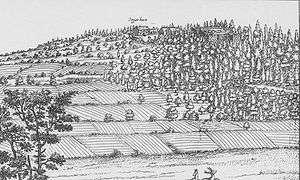Battle of the Alte Veste
Coordinates: 49°27′10″N 10°57′55″E / 49.45278°N 10.96528°E
| Battle of Alte Veste | |||||||
|---|---|---|---|---|---|---|---|
| Part of the Thirty Years' War | |||||||
 The Alte Veste in 1705, by Johann Alexander Boener. | |||||||
| |||||||
| Belligerents | |||||||
|
|
| ||||||
| Commanders and leaders | |||||||
|
|
| ||||||
| Strength | |||||||
|
45, 430 men 30,011 infantry in 37 regiments and 306 companies. 15, 419 cavalry in 39 regiments and 263+ companies[2] | 40,000 men | ||||||
| Casualties and losses | |||||||
| ~4,000 killed or wounded[3] | ~2,000 killed or wounded[3] | ||||||
The Battle of the Alte Veste was a significant battle of the Thirty Years' War.
Background
In the late summer of 1632 the army of Swedish King Gustavus Adolphus met Albrecht von Wallenstein near Nürnberg. The successes of Gustavus Adolphus over General Tilly forced Holy Roman Emperor Ferdinand II to recall Albrecht von Wallenstein into military service from retirement. Wallenstein was unmatched in his ability to raise troops, and within a few weeks he took to the field with a fresh army.
The Imperial Army's ranks swelled as Wallenstein moved to stop the Swedes advance at Nuremberg. Repeatedly, Gustav Adolf formed for battle and challenged Wallenstein to come out of his fortified camp, but was refused. As the supply situation continued to worsen, the impetuous King grew desperate.
Attack
He attacked the Imperial camp at the Alte Veste (or "Old Fortress")—a derelict castle situated atop a wooded hill. Its ownership would then allow the Swedish guns to dominate the Imperial camp. The Imperials were prepared with trenches and an abatis that stymied the Swedish advance. When the vaunted brigades faltered, much of the cavalry was sent in dismounted. Wallenstein saw an opportunity to strike a blow and sallied his cavalry and cut down many of the exhausted troops. Only the final introduction of the Swedish cavalry reserve was able to avert a complete disaster.
Result
The Swedes had been defeated. The Commander of the Swedish artillery, Lennart Torstenson, was taken prisoner and locked up for nearly a year at Ingolstadt. Gustav Adolf received reinforcements days later and Wallenstein left camp and moved north.
References
- 1 2 August 31 (old style or pre-acceptance of the Gregorian calendar in the Protestant region) September 9 (new style, or Gregorian dating), 1632.
- ↑ http://www.cgsc.edu/CARL/nafziger/632HAA.pdf
- 1 2 Lunde, Henrik O.: A Warrior Dynasty: The Rise and Decline of Sweden as a Military Superpower. Philadelphia; Oxford: Casemate, 2014, ISBN 1612002420, p. 149.